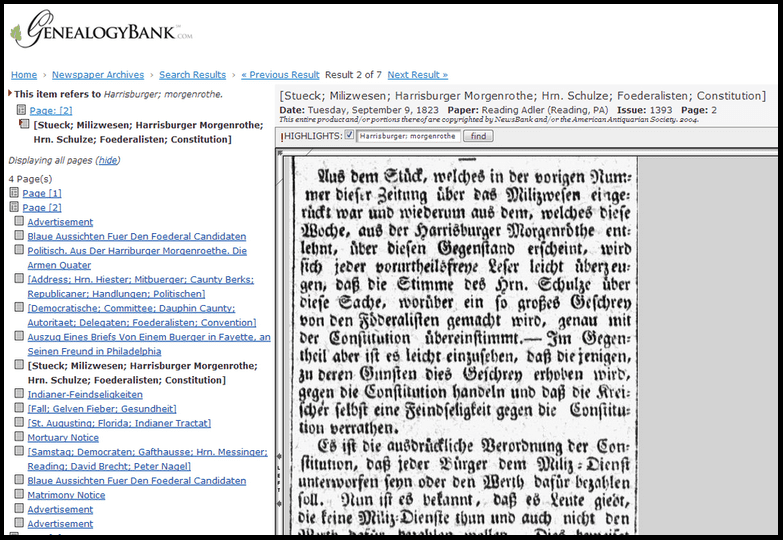Introduction: In this article, Mary Harrell-Sesniak provides search tips to help you find your German ancestors in GenealogyBank’s online collection of German American newspapers. Mary is a genealogist, author and editor with a strong technology background.
German Genealogy Research Tips
America has long been a prized destination for immigrants. In the case of our German American ancestors (known as Deutschamerikaner), many arrived during the early years of the British colonies—with evidence dating to the 17th Century.
This long history of German immigrants in America can be researched in the many German American newspapers, or “Deutsch-Amerikanische Zeitungen,“ found in GenealogyBank’s Historical Newspaper Archives.
Early German American immigrants were especially drawn to New York and Pennsylvania, with families typically settling among those of their same origins. Later there were westward migrations, most notably in Midwestern areas such as Cincinnati, Chicago, St. Louis, Milwaukee and northern Kentucky. In many of these areas, you can still find strong German influences on the culture, customs and food. In Cincinnati for example, where I attended elementary school, I remember that the cafeteria often served sausage and sauerkraut—a dish we no longer encountered when our family moved south.
Immigrant community names are often reminiscent of their homelands, as demonstrated in this 1732 estate notice from the American Weekly Mercury:
“To be Sold by Richard Martin Executor of William Harmon of Upper-Dublin, in the County of Philadelphia, deceas’d…a considerable Quantity of clear’d Land and good Meadowing in Dublin-Township; and One Hundred and Ten Acres of Land near Germantown…”
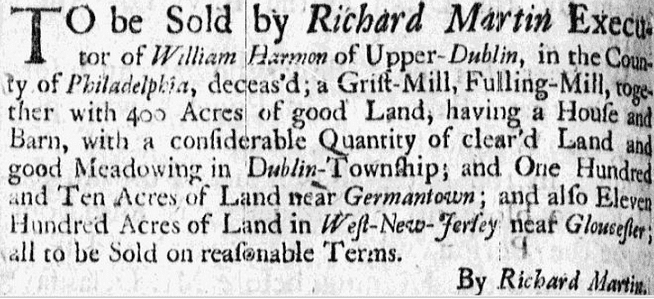
This estate notice was published in the same year that Founding Father Benjamin Franklin (1706-1790) published the first German-language newspaper in America, the Philadelphische Zeitung.
Although Franklin’s newspaper didn’t last even a year, publishers recognized the need to communicate with the German-speaking population. So it is common to see bilingual papers with the placement of foreign language articles and advertisements side-by-side with those printed in English.

In the above example from the Pennsylvania Gazette we see a German-language notice regarding an Evangelical Conference; followed by an English-language estate notice for Joseph Woollen, late of Germantown Township; and an English-language ad for the The Pocket Almanack. Note the reference in the last ad to Poor Richard’s Almanack, another of Benjamin Franklin’s publications, which appeared from 1732-1758.
There was such a desire to publish newspapers in German that in 1775, one of the Committees of Correspondence resolved that their notice should “be published both in the English and German news-papers,” as reported at the end of the following article.
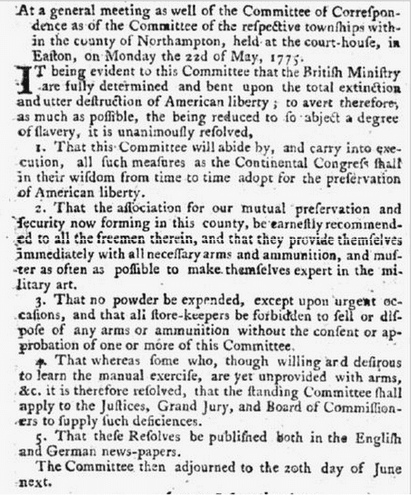
Their concern was that the British Ministry was “fully determined and bent upon the total extinction and utter destruction of American liberty.” These Committees, as noted in a Wikipedia article, were an integral part of the colonists’ resistance to British rule, providing coordinated efforts to distribute information for their safety.
When it comes to researching German ancestry, there is clearly a lot of good family history information in German American newspapers—so how does one begin one’s search for German ancestors in historical newspapers?
How to Search & Read German-Language American Newspapers
It helps if you are fluent in German, but if not, don’t despair—try the following strategies.
Familiarize yourself with common Germanic words found in ancestral birth, marriage and death notices. Numerous lists can be found on the Web, but here are some commonly-used terms:
- Familial relationships: wife (frau, gattin), mother (mutter), father (vater, väter), son (sohn), daughter (tochter)
- Genealogical events: birth (geburt), born (geboren), married (verheiratet), death (tod, todesfall), died (starb, gestorben), buried (begraben, bestatten)
- Days of the week (in order): Montag, Dienstag, Mittwoch, Donnerstag, Freitag, Samstag, Sonntag
- Months (in order): Januar, Februar, März, April, Mai, Juni, Juli, August, September, Oktober, November, Dezember
Use a language translator, such as Google Translate (at translate.google.com) to translate German to English. If a word or phrase doesn’t translate exactly, try breaking it into parts. For instance, the newspaper Volksfreund doesn’t translate, but if you separate the two parts into “Volks” and “freund” the translator will respond with “people friendly,” indicating that the translation of the newspaper’s name is something like People’s Friend.
Try alternate spelling variations (don’t expect standardization). If the translator fails, experiment with changing a few letters. Local dialects affect spellings, and over time the accepted way to spell words has changed. FamilySearch’s German Word List, located at https://familysearch.org/learn/wiki/en/German_Word_List, will give you a head start. Some of its suggestions are to interchange: p for b; a for e; and t for d or dt.
“Americanize” spellings. Although German words typically have umlauts applied to letters, such as ä or ü, GenealogyBank’s search engine may perform better if you ignore them.
Let GenealogyBank’s search engine identify what type of article is on a newspaper page. If you are struggling with the description presented, expand the page information on the left-hand side of the screen, where GenealogyBank’s search engine notes the types of articles found on the newspaper page. In this example, the content of this newspaper’s page two is listed with many German descriptions—but the search engine also explains, in English, that there are advertisements, mortuary notices, and matrimony notices on this page—helping you to better understand the content you are looking at on page two.
Finally, it’s useful to learn as much as you can about a particular German American newspaper publication. Where was it published? Who was the editor? When did it initiate and cease publication? Were there gaps in coverage, and was it ever published under an alternate name?
In this example, I expanded an article to view the nameplate of the 16 March 1801 (16ten Merz) edition of Die Harrisburger Morgenrothe. With this expanded view, we can read that this newspaper (diese zeitung) was published every Monday morning (Montag morgen) in Harrisburg, Pennsylvania.
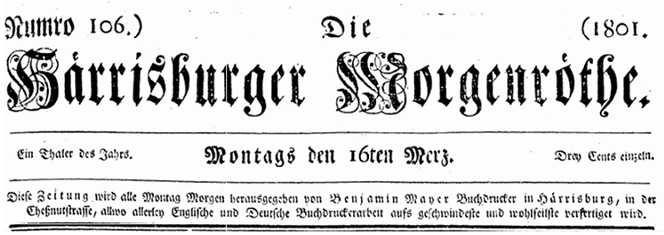
Some of this information can be confirmed at the Library of Congress’s website U.S Newspaper Directory, 1690-Present, located at http://chroniclingamerica.loc.gov/search/titles/. Not only is it a comprehensive list of every known newspaper, but it also serves as a target list for potential research.
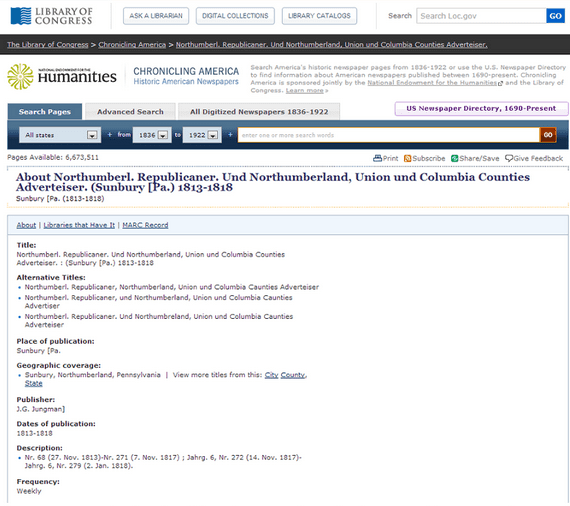
For example, this is the information I found about the German American newspaper Die Harrisburger Morgenrothe using the Library of Congress Newspaper Directory site:
- Title: Die Harrisburger Morgenrothe und Dauphin und Cumberland Caunties Anzeiger: (Harrisburg [Pa.]) 1827-1839
- Alternative Titles: Harrisburger Morgenrothe, Morgenrothe
- Place of publication: Harrisburg [Pa.]
- Publisher: Wm. Boyer und J. Baab
- Dates of publication: 1827-1839; Nr. 1476 (11 Aug. 1827)-Nr. 2142 (9 Mai 1839)
- Frequency: Weekly
- Language: German
Examples of German American Newspaper Mastheads


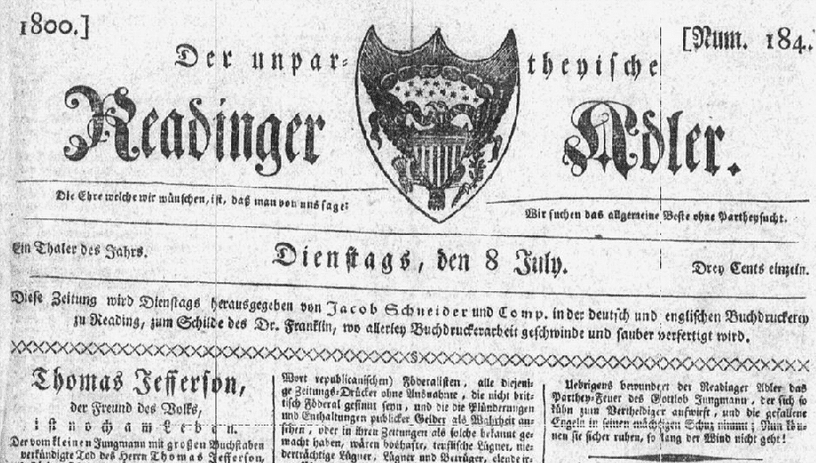
Example of a German American Newspaper Obituary (Gov. Frank Higgins)
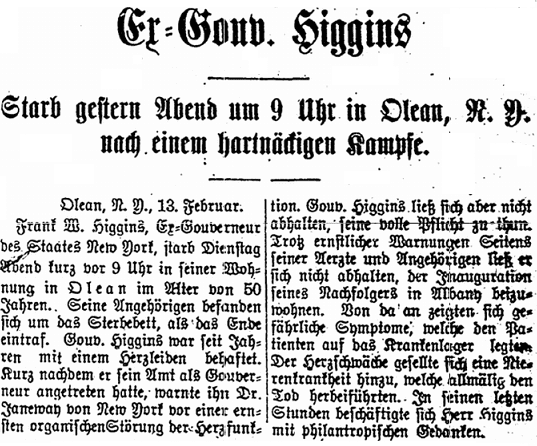
For more information, read Mary’s earlier Blog article:

